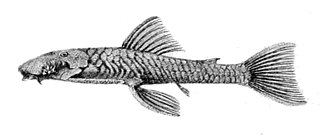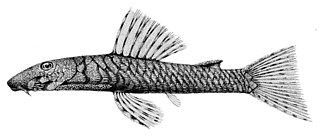
Ancistrus is a genus of nocturnal freshwater fish in the family Loricariidae of order Siluriformes, native to freshwater habitats in South America and Panama. Fish of this genus are common in the aquarium trade where they are known as bushynose or bristlenose catfish. In the aquarium hobby they are often referred to as bushynose or bristlenose plecos instead, but this may lead to confusion as "pleco" usually is used for Hypostomus plecostomus and its allies and is often used as a catchall term for any loricariids remotely resembling that species.

The Hypostominae are a subfamily of catfishes of the family Loricariidae. Most members of the subfamily are restricted to tropical and subtropical South America, but there are also several species in southern Central America. Hypostomus plecostomus, which is popular in the aquarium trade, has been introduced to several regions far from its native range.
Ancistrus macrophthalmus is a species of catfish in the family Loricariidae. It is native to South America, where it occurs in the Orinoco River and its lower tributaries in Venezuela. The species reaches 7.9 cm SL. It is occasionally seen in the aquarium trade, where it is one of multiple species sometimes referred to as "medusa plecos".
Ancistrus sericeus is a species of catfish in the family Loricariidae. It is native to South America, where it occurs in the basin of the Ampiyacu River, a tributary of the Amazon River, in Peru. The species reaches 5 cm SL.
Ancistrus chagresi is a species of catfish in the family Loricariidae. It is native to Central America, where it occurs near the Panama Canal in the basins of the Chagres River, the Chorrera River, and the Gatún River. The species reaches 19.5 cm SL.
Ancistrus jataiensis is a species of catfish in the family Loricariidae. It is a freshwater species native to South America, where it is only known from córrego Jataí, which is a small tributary of the Vermelho River in the Tocantins River basin in Brazil. The species reaches 5.4 cm SL.
Ancistrus parecis is a species of catfish in the family Loricariidae. It is native to South America, where it occurs in the Tapajós River basin in Brazil. Its specific epithet refers to the Parecis Plateau, where the type specimen was collected. The species reaches 6 cm SL.
Ancistrus amaris is a species of catfish in the family Loricariidae. It is native to South America, where it occurs in the Orinoco River and Apure River basins in Venezuela. The species reaches at least 11.57 cm SL and was described in 2019 by Lesley S. de Souza of the Field Museum of Natural History, Donald C. Taphorn of the Royal Ontario Museum, and Jonathan Armbruster of Auburn University alongside five other species of Ancistrus. FishBase does not list this species.

Ancistrus greeni is a species of catfish in the family Loricariidae. It is native to South America, where it occurs in the Madre de Dios River and Inambari River basins in Peru. The species reaches 6.5 cm in total length.
Ancistrus saudades is a species of catfish in the family Loricariidae. It is native to South America, where it occurs in the basins of the Takutu River, the Ventuari River, the Caroní River, and the Caura River in Guyana, Venezuela, and Brazil. The species reaches at least 10.75 cm SL and was described in 2019 by Lesley S. de Souza of the Field Museum of Natural History, Donald C. Taphorn of the Royal Ontario Museum, and Jonathan Armbruster of Auburn University alongside five other species of Ancistrus. FishBase does not list this species.
Ancistrus yutajae is a species of catfish in the family Loricariidae. It is native to South America, where it occurs only in the Yutajé River in Venezuela. The species reaches at least 8.28 cm SL and was described in 2019 by Lesley S. de Souza of the Field Museum of Natural History, Donald C. Taphorn of the Royal Ontario Museum, and Jonathan Armbruster of Auburn University alongside five other species of Ancistrus. FishBase does not list this species.
Ancistrus heterorhynchus is a species of catfish in the family Loricariidae. It is native to South America, where it occurs in the Inambari River basin, which is part of the Madre de Dios River drainage in Peru. The species reaches 6.3 cm SL and is known to inhabit high-altitude areas.

Ancistrus marcapatae is a species of catfish in the family Loricariidae. It is native to South America, where it occurs in the Inambari River basin, which is part of the Madeira River drainage in Peru. The species reaches 12.4 cm in total length.
Ancistrus occloi is a species of catfish in the family Loricariidae. It is a freshwater fish native to South America, where it occurs in the Urubamba River basin in Peru. The species reaches 11.6 cm SL and is noted to inhabit high-altitude areas.
Ancistrus reisi is a species of catfish in the family Loricariidae. It is a freshwater fish native to South America, where it is known to occur in small rivers in the state of Tocantins in Brazil. The species reaches 6.1 cm SL and is distinguished from most members of the genus by the absence of an adipose fin, which for this species is replaced by a series of unpaired platelets that form a low crest.
Ancistrus tolima is a species of catfish in the family Loricariidae. It is native to South America, where it occurs in the Magdalena River drainage, which is part of the Prado River basin in Colombia. The species reaches 7.7 cm SL. Its specific epithet is a reference to Colombia's Tolima Department, which contains the type locality of the species.
Ancistrus tombador is a species of catfish in the family Loricariidae. It is native to South America, where it is known to occur in small rivers in the state of Mato Grosso in Brazil. The species reaches 6.3 cm SL and is distinguished from other members of the genus Ancistrus by the absence of an adipose fin, which in this species is replaced by a series of unpaired platelets that form a low crest. The specific epithet of this species refers to Serra do Tombador, where the type specimen was collected.
Ancistrus verecundus is a species of catfish in the family Loricariidae. It is native to South America, where it occurs in the Madeira River basin in Brazil. The species reaches 5.5 cm SL. Its specific epithet, verecundus, derives from Latin and means "modest" or "bashful", referencing the absence or reduced presence of tentacles on the snout of the species.
Ancistrus vericaucanus is a species of catfish in the family Loricariidae. It is native to South America, where it occurs in the basin of the Cauca River, which is a tributary of the Magdalena River, in Colombia. It reaches 7.2 cm SL. Its congener Ancistrus caucanus was once thought to inhabit the Cauca River basin and was named after the river itself, but it was determined in 2013 that A. caucanus was not actually native to the Cauca. The specific epithet of A. vericaucanus means "true caucanus", in reference to the misleading name of A. caucanus.
Ancistrus patronus is a species of catfish in the family Loricariidae. It is native to South America, where it occurs in the Orinoco basin in Venezuela. The species reaches at least 8.6 cm SL and was described in 2019 by Lesley S. de Souza of the Field Museum of Natural History, Donald C. Taphorn of the Royal Ontario Museum, and Jonathan Armbruster of Auburn University alongside five other species of Ancistrus. Its specific name means "defender" in Latin and was given to the species due to the reported tendency of male A. patronus to actively guard their nests and protect their young until they are relatively large.



